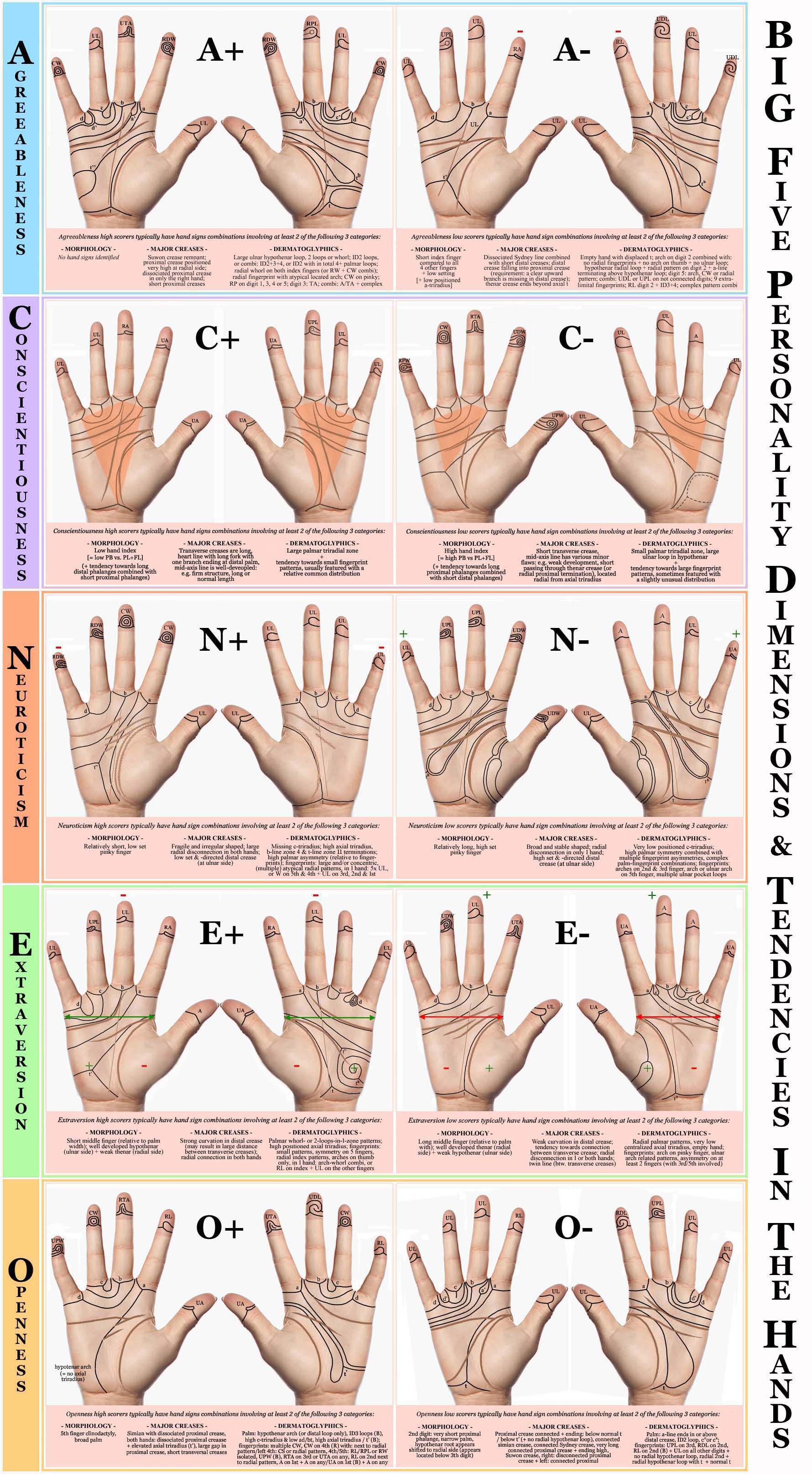
Major hand signs & the General Factor of Personality (a.k.a. 'trait EQ')
This article presents a new framework on the hands
in relation to personality & intelligence!

In the 2nd half of the 20th century a tradition was established in the academic fields of psychology where individual behavior was assumed to include 3 major components (see also picture):
(1) personality [a.k.a. Big Five model]
(2) emotional intelligence [a.k.a. EQ]
(3) cognitive intelligence [a.k.a. IQ].
In the 21 century researchers began to develop a groundbreaking view where personality (1st component) became understood representing actually a part of the emotional intelligence (2nd component).
This is how emotional intelligence [EI] became split into two sub-components, named: 'trait emotional intelligence' [trait EI] & 'ability emotional intelligence' [ability EI].
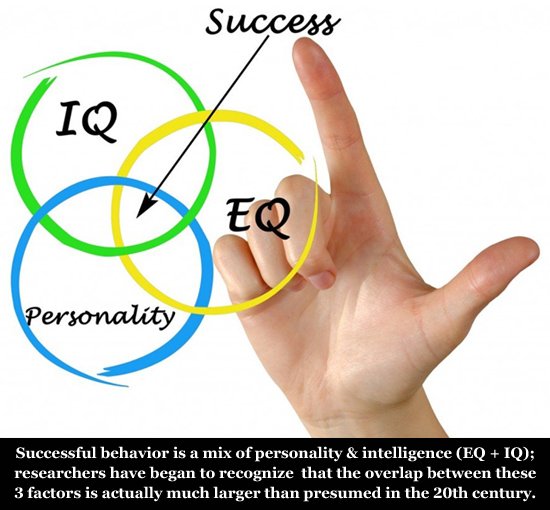
Later, empirical studies have confirmed that the so-called 'general factor of personality' [GFP] has a very large overlap with trait EI, which can also be referred to as 'trait EQ'; additionally, this GFP also has a considerable positive but moderate correlation with ability EI. This suggests that GFP and trait EI can likely even be considered to represent synonyms (source: van der Linden, 2016).
Trait EI (a.k.a. trait EQ) is formally defined as a constellation of emotional perceptions operationalized via questionnaires and ratings scales; an alternative label for the same construct is 'trait emotional self-efficacy'). While ability EI (a.k.a. ability EQ) is often defined as a set of emotion-related cognitive abilities that ought to be measured via maximum performance tests.
Briefly summarized: the Big Five model became in 21 century recognized to serve as a measure for exploring both personality as well as a major aspect involving the concept of EQ, which is a.k.a. the emotional intelligence coëfficient. The picture below presents a visual illustration [modified from the 2016 van der Linden report - figure 2, page 64] describing the fundamental grounds which demonstrate how each of the Big Five dimensions is connected with the concept of (trait) emotional intelligence with a considerably high correlation factor (with a negative correlation relationship for Neuroticism only, the others are positive).
NOTICE: Picture below (modified after van der Linden 2016) describes the fundamental relationships between the Big Five personality dimensions and 'trait emotional intelligence' (or trait EQ); in the continuation of this article GFP will be referred to represent 'cognitive efficiency', Alpha represents 'cognitive stability', and Beta represents 'cognitive flexibility'.
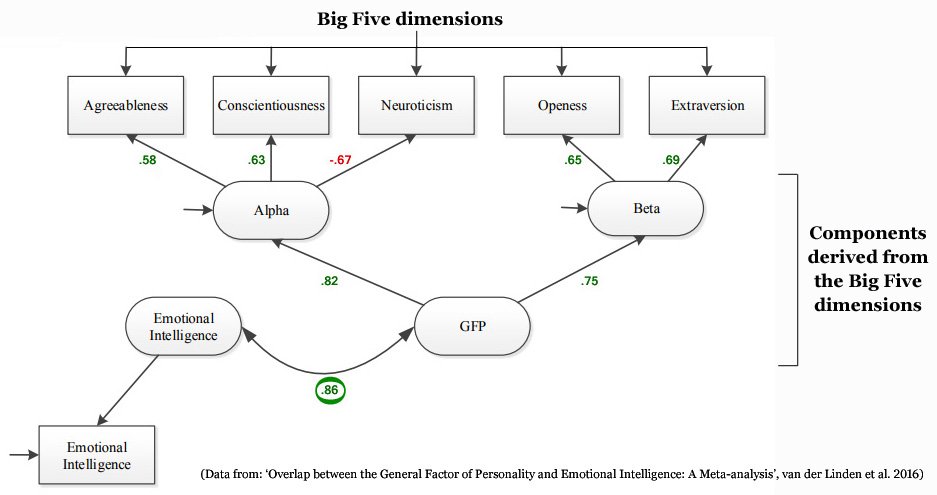
The continuation of this article presents a brief study exploring the potential effect-size of individual major hand signs on the 'general factor of personality'. The study involves a sample of 262 subjects who have performed the Dutch version of the NEO PI-R questionnaire - which represents a tool for assessing the Big Five personality dimensions. The results - which are based on sub-population comparisons relative to controls - suggest that individual hand signs in various dimensions of the hand bare the potential to have a small but considerable impact on the self-perceptions in (some) individuals in the sub-populations.

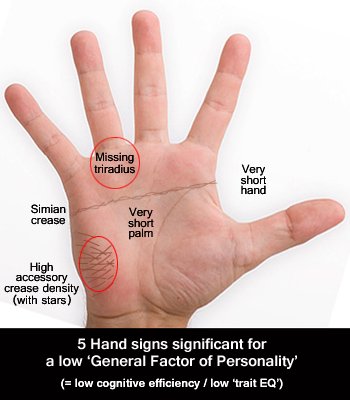
In 5 out of the 29 studied major hand signs the impact of the effect-size is higher than 10% for the derived Big Five component 'cognitive efficiency'; curiously in all these 5 hand signs the results reflect a tendency towards low scores in terms of the 'general factor of personality'.
These 5 most significant major hand signs for the General Factor personality are (listed by order of effect-size):
• Short palms (-12,1%; N=38)
• Short hands (-14,9%; N=22)
• Missing c-triradius (-15,5%; N=19)
• High accessory crease density, often with stars (-13,2%; N=21)
• Simian crease (-13,3%; N=19)
Only in 3 out of the 262 studied subjects at least three out of these five major hand signs are present - see hand prints displayed below. All three subjects belong to the 12% the lowest scorers for the 'General Factor of Personality' - low scores signal self-perceived low trait EQ (almost 94% of the studied subjects has a trait EQ score in the range of 3 to 7 - on a scale varying from 1 to 9).
Hand prints of three subjects with at least 3 out of 5 hand signs associated with a low 'General Factor of Personality';
high resolution version of these hand prints is available HERE
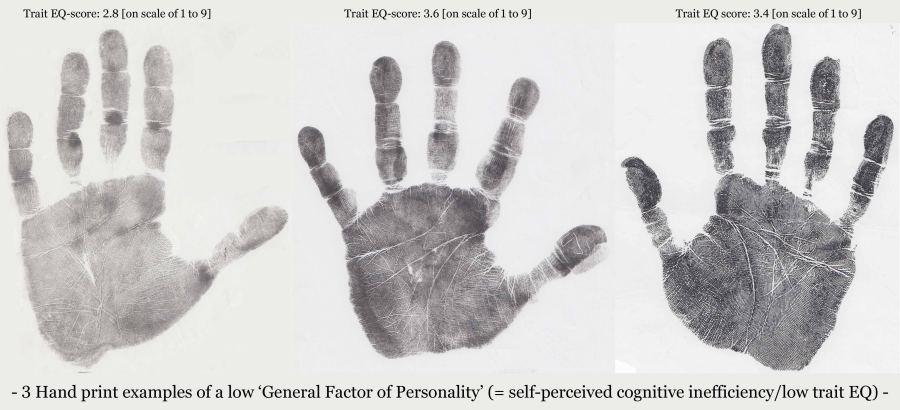
The overall results also show a slight tendency for extraordinary hand signs (especially the biometric hand signs) to have an association with slightly below average scores for the Big Five personality dimensions Agreeableness, Conscientiousness, Extraversion & Openness; and slightly below average scores for Neuroticism.
More details involving the research method + the results are presented in the sections below.

- RESEARCH METHOD -
The Dutch version of the NEO PI-R questionnaire has been used to assess the Big Five profile scores for 262 subjects; psycho dynamic components have been derived from the Big Five scores by means of the following principles:
• Cognitive efficiency [= GFP / trait EQ] = Agreeableness + Conscientiousness + Extraversion + Openness - Neuroticism
• Cognitive stability [= Alpha / stability] = Agreeableness + Conscientiousness - Neuroticism
• Cognitive flexibility [= Beta / plasticity] = Extraversion + Openness
• Temperament = Neuroticism & Extraversion combined (N+ with E+ = choleric temperament, N+ with E- = melancholic temperament, N- with E+ = sanguine temperament, N- with E- = phlegmatic temperament)
Percentual differences involving the normalized NEO PI-R scores (varying from 1 to 9) have been charted for 29 major hand signs in 4 categories: I - biometic proportions, II - creases, III - palmar dermatoglyphics & IV - fingerprints. Within each of the four categories every hand sign has been compared with a control population consisting of the cases which do not have any of the hand signs (each of the four control groups includes about half of the full research population).
Inside each chart every hand sign has been labeled with color based on the average score for the 'cognitive efficiency' component; colors are based on the color spectrum displayed above the upper 'cognitive efficiency' scale - an empty chart is displayed in the picture below.
IMPORTANT: Inside each chart the Big Five dimension NEUROTICISM is displayed in reversed manner in order to make the crucial impact of this dimension visible; also, the percentages displayed for the temperament component reflect simply the lowest value on the Neuroticism & Extraversion scales.
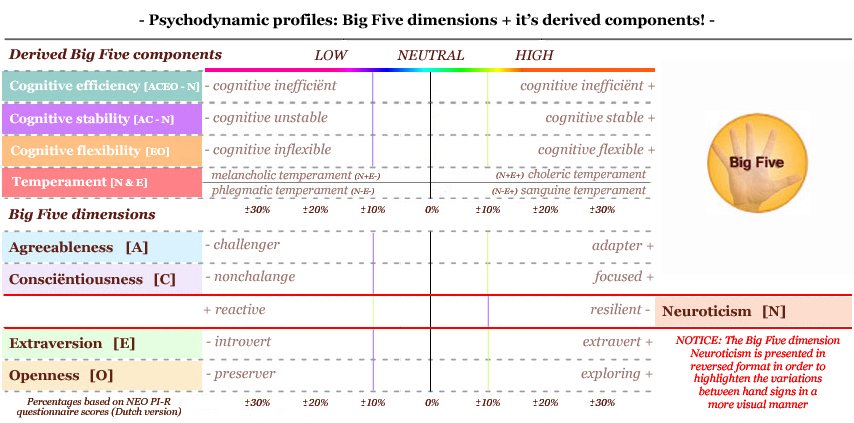
- RESULTS -
A short summary of the results is presented here for each of the four hand sign categories; additionally only the results with an impact above 10% are described below.
I - Biometric proportions:
The chart below displays the results for 8 biometric variations (2 based on overall hand shape, 2 based on palm shape, 2 based on finger length to palm length, and 2 based on finger length to palm breadth). For each hand sign only cases with extraordinary variations have been included in the analysis; the control population for the biometric category involves 128 subjects - all have them do not show enough variation to become included in the analysis for any of the 8 biometric hand signs.
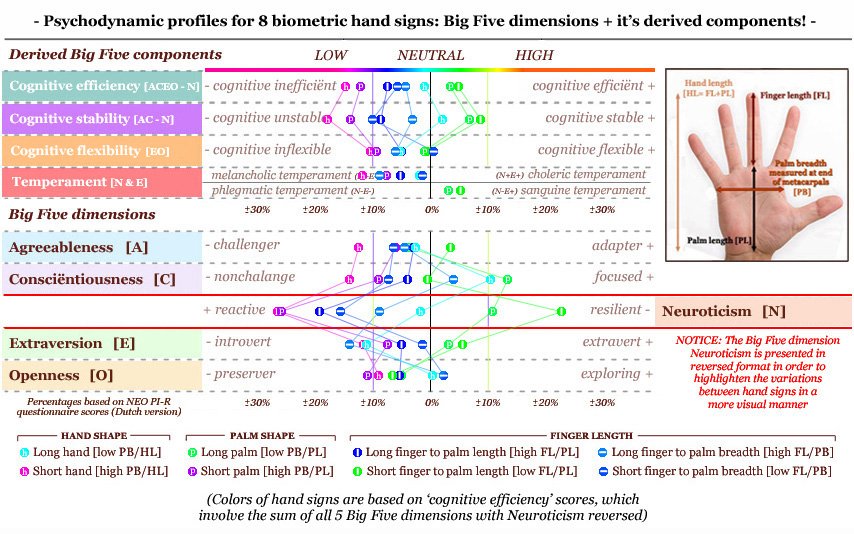
Observations for the 8 biometric hand signs (a brief report involving the results larger than 10% only):
• Ia - Long/narrow hand shape, both hands [hyperdolichocheir: extraordinary low PB/HL values = hand index < 0,41] (N=21):
Results associated with long hand shape are only became manifest for two of the Big Five dimensions: low Extraversion (-11,2%) & high Conscientiousness (+10,4%).
• Ib - Short/broad hand shape in both hands [hyperbrachycheir: extraordinary high PB/HL values = hand index > 0,50] (N=22):
Results associated with short hand shape are rather remarkable: all Big Five scores point towards self-perceived cognitive inefficiency (-14,9%), with both cognitive instability (-17,9%) & inflexibility (-10,5%) involved, only the Big Five dimension Openness did not produce a value above 10%. The results also point in the direction of a tendency towards a 'melancholic temperament'.
• Ic - Long/narrow palm shape in both hands [extraordinary low PB/PL values: palm index < 0,75] (N=30):
Results associated with long palm shape only became manifest for two of the Big Five dimensions: high scores for Conscientiousness (+13,4%) & low scores for Neuroticism (-10,7%).
• Id - Short/broad palm shape in both hands [extraordinary high PB/PL values: palm index > 0,82] (N=38):
Results associated with short palm shape are rather remarkable: all Big Five scores point towards self-perceived cognitive inefficiency (-12,1%), with especially cognitive instability (-13,9%) involved; scores above 10% became especially manifest for high Neuroticism (+26,1%), and in a lesser degree for low Openness (-11,0%).
• Ie - Long finger length to palm length in both hands [extraordinary high FL/PL values: > 0,80] (N=31):
Results associated with long finger length to palm length: only a score above 10% involving high scores for the Big Five dimension Neuroticism (+19,4%).
• If - Short finger length to palm length in both hands [extraordinary low FL/PL values: < 0,71] (N=31):
Results associated with short finger length to palm length: only a score above 10% involving low scores for the Big Five dimension Neuroticism (-22,9%).
• Ig - Long finger length to palm breadth in both hands [extraordinary high FL/PL values: > 1,05] (N=44):
Results associated with long finger length to palm breadth: only a score above 10% involving low scores for the Big Five dimension Extraversion (-14,4%).
• Ih - Short finger length to palm breadth in both hands [extraordinary low FL/PL values: < 0,90] (N=39):
Results associated with short finger length to palm breadth: only a score above 10% involving high scores for the Big Five dimension Neuroticism (+15,8%), resulting in a borderline score for cognitive instability (-10,0%).
II - Palmar crease:
The chart below displays the results for 8 palm crease variations (5 based on transverse crease variations, 1 is based on a different radial termination point for the head line & life line, and 2 involve extreme variations involve accessory crease density). The control population for the palmar crease category involves 133 subjects - all have them do not show enough variation to become included in the analysis for any of the 8 palmar crease hand signs.
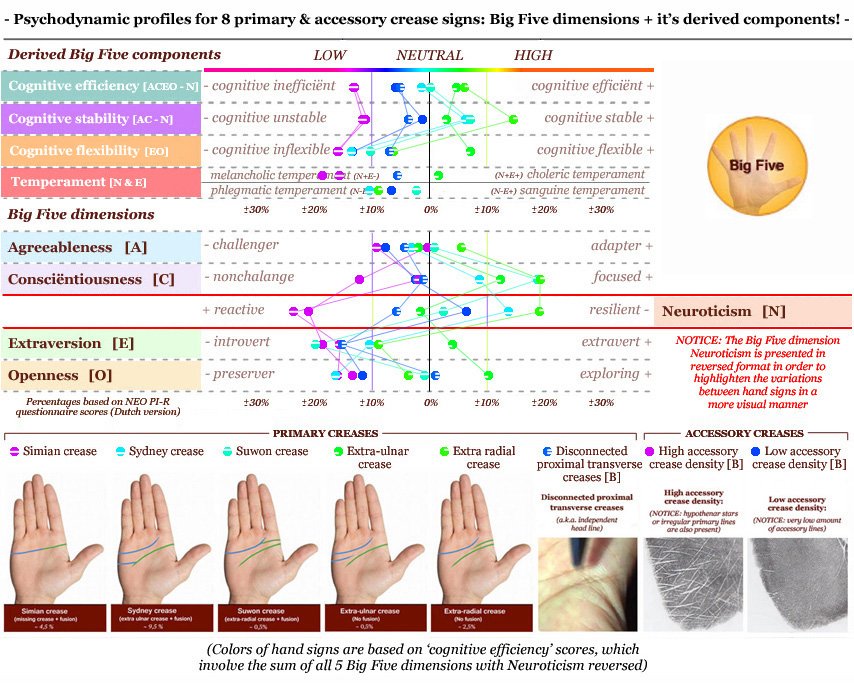
Observations for the 8 palmar crease hand signs (a brief report involving the results larger than 10% only):
• IIa - Simian crease [a.k.a. simian line, single transverse crease] (N=19):
Results associated with simian crease related variations are rather remarkable: all Big Five scores point toward self-perceived cognitive inefficiency (-13,3%) with both inflexibility (-15,9%) & cognitive instability (-11,7%) involved; the average value was just below -10% for Agreeablness, only the Big Five dimension Conscientiousness did clearly not produce a value above 10%. The results also point in the direction of a tendency towards a 'melancholic temperament'.
* More details: Psychodynamic profiles for simian line variations
• IIb - Sydney crease [a.k.a. Sydney line, extraordinary long proximal crease] (N=36):
Results associated with Sydney crease variations show a clear pattern: pointing in the direction of self-perceived cognitive inflexibility (-13,5%) based on low scores on the Big Five dimensions Openness (-16,4%) & Extraversion (-10,5%); additionally, there is also an apparant low score for Neuroticism (-13,8%). The results point in the direction of a tendency towards a 'phlegmatic temperament'.
• IIc - Suwon crease [a.k.a. Suwon line, extraordinary long distal crease] (N=15):
Results associated with Suwon crease variations: pointing in the direction of self-perceived cognitive inflexibility (-10,4%) based on remarkable low scores on the Big Five dimensions Extraversion (-19,9%); additionally, there is also an apparant high score for Conscientiousness (+18,6%).
• IId - Extra-ulnar crease (N=14):
Results associated with extra-ulnar crease variations: high scores for especially Conscientiousness (+12,3%) & a borderline effect for high scores for Openness (+10,1%).
• IIe - Extra-radial crease (N=4):
Results associated with radial-ulnar crease variations: pointing in the direction of self-perceived cognitive stability (+14,6%) based low scores for the Big Five dimension Neuroticism (-19,2%), and high scores for the Big Five dimension Conscientiousness (+18,9%).
• IIf - Disconnected proximal creases in both hands [a.k.a. independend head lines] (N=42):
Results associated disconnected proximal creases: only a score above 10% involving low scores for the Big Five dimension Extraversion (-15,1%).
• IIg - High accessory crease density, often featured with formation of multiple stars in the hypothenar zone (N=21):
Results associated with high accessory crease density are rather remarkable: all Big Five scores point towards self-perceived cognitive inefficiency (-13,2%) with both cognitive inflexibility (-16,1%) & instability (-11,2%) involved; only the Big Five dimension Agreeableness did not produce a value above 10%. The results also point in the direction of a tendency towards a 'melancholic temperament'.
• IIh - Low accessory crease density (N=21):
Results associated with low accessory crease density: pointing in the direction of self-perceived cognitive inflexibility (-13,2%) based on low scores on the Big Five dimension Extraversion (-15,1%) & low scores for Openness (-11,8%).
10-20-2017 UPDATE: A new study became available describing the impact of the aberrant transversal crease variations (involing the simian line, Sydney line & Suwon line):
Aberrant Transverse Flexion Creases point towards:'Low Personality Plasticity' (= cognitive inflexibility)
III - Palmar dermatoglyphics:
The chart below displays the results for 8 palmar dermatoglyphic variations (2 involving the upper palm, 5 involving the hypothenar zone, and 1 involving the thenar zone). The control population for the palmar dermatoglyphics category involves 142 subjects - all have them do not have any of the 8 palmar dermatoglyphic hand signs.
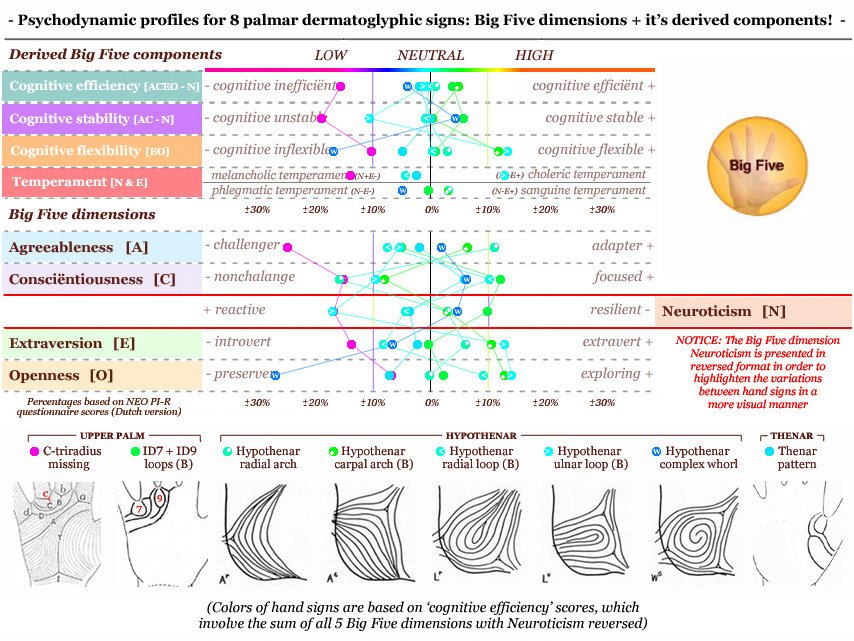
Observations for the 8 palmar dermatoglyphic hand signs (a brief report involving the results larger than 10% only):
• IIIa - C-triradius is missing [a.k.a. absent triradius in the palmar zone below the ring finger] (N=19):
Results associated with an missing c-triradius are rather remarkable: all Big Five scores point toward self-perceived cognitive inefficiency (-15,5%) with both cognitive instability (-18,9%) & inflexibility (-10,4%) involved; only the Big Five dimension Openness did clearly not produce a value above 10%. The results also point in the direction of a tendency towards a 'melancholic temperament'.
• IIIb - ID7 + ID9 loops in both hands [in the palmar zones between the pinky & ring finger, plus ring- & middle finger] (N=16):
Results associated with the combination of ID7 and ID9 loops: only a score above 10% involving high scores for the Big Five dimension Conscientiousness (+12,2%).
• IIIc - Hypothenar radial arch [axial triradius shifted towards the ulnar border of the palm, usually halfway upward on the hypothenar] (N=8):
Results associated with a hypothenar carpal arch: only became manifest for two of the Big Five dimensions: low scores for Conscientiousness (-15,8%) & high scores for Agreeableness (+11,2%).
• IIId - Hypothenar carpal arch in both hands [axial triradius shifted upward in at least the 2nd third of hypothenar zone] (N=50):
Results associated with a hypothenar radial arch {typically found on the right hand only}: pointing in the direction of self-perceived high cognitive flexibility (+11,8%) based on low scores on the Big Five dimensions Openness (+12,9%) & Extraversion (+10,6%).
• IIIe - Hypothenar radial loop in both hands (N=20):
Results associated with hypothenar radial loops: only a score just above 10% involving high scores for the Big Five dimension Conscientiousness (+10,2%).
• IIIf - Hypothenar ulnar loop in both hands (N=7):
Results associated with hypothenar ulnar loops: various Big Five scores point toward self-perceived cognitive instability (-10,6%) & high flexibility (+13,5%), via high scores on the dimensions Openness (+14,0%) & Extraversion (+12,9%), and considerably high scores on Neuroticism (+17,0%).
• IIIg - Hypothenar complex whorl (N=19):
Results associated a complex whorl on the hypothenar: manifesting with self-perceived inflexibility (-16,9%), with especially very low scores on the Big Five dimension Openness (-27,0%).
• IIIh - Thenar pattern (N=32):
Results associated any form of a thenar pattern in at least one hand: no scores above 10% at all. NOTICE: An additional analysis has also been made for 11 cases which have a thenar pattern in both hands; this analysis produced similar scores for nearly all Big Five domains and the derived components with only a single exception: a rather remarkable high score for the Big domain Agreeableness (+17,4%) - by far the highest score noticed for Agreeableness (none of the other hand signs explored in this study has produced a score above +10% for this Big Five dimension!).
IV - Fingerprint patterns:
The chart below displays the results for 8 fingerprint pattern variations (arches, tented arches, ulnar loops, radial loops, and whorls). The control population for the fingerprint category involves 150 subjects - all have them do not have any of the 5 fingerprint pattern combinations.
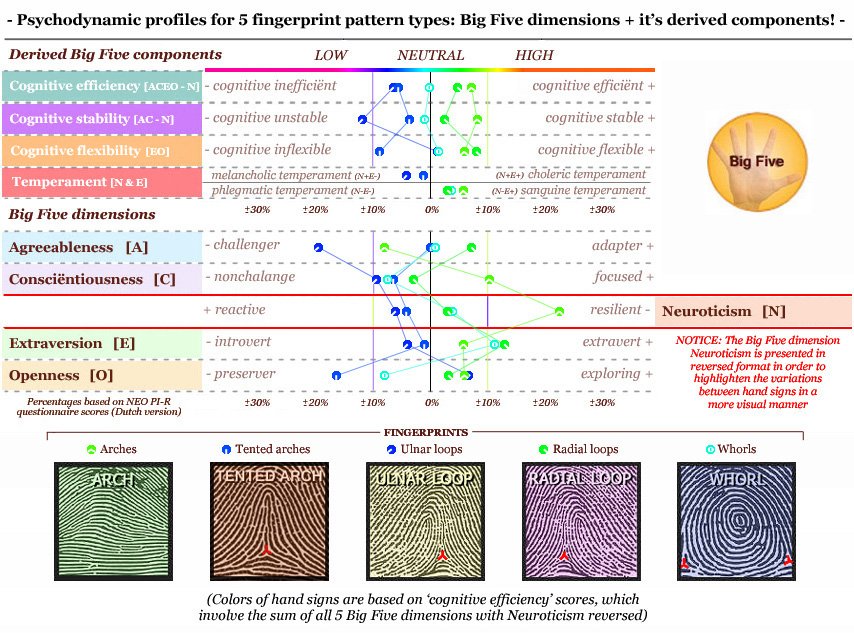
Observations for the 5 fingerprint hand signs (a brief report involving the results larger than 10% only):
• IVa - Arch fingerprints: multiple, tented arches with a high pole NOT included (N=29):
Results associated with multiple arch pattern fingerprints: a remarkable resulting pointing in the direction of low scores on the Big Five dimension Neuroticism (-22,6%), also a tendency towards high scores on the Big Five dimension Conscientiousness (+10,3%).
• IVb - Tented arch: high pole required (N=14):
Results associated with tented arches: only a score above 10% involving low scores for the Big Five dimension Openness (-16,5%).
• IVc - Ulnar loops: 10x = on all fingers (N=20):
Results associated with 10 ulnar loops: only a score above 10% involving low scores for the Big Five dimension Agreeableness (-19,5%), which also results in low cognitive instability (-11,8%).
• IVd - Radial loops: on both index fingers (N=17):
Results associated with radial loops on both index fingers: only a score above 10% involving high scores for the Big Five dimension Extraversion (+12,8%).
• IVe - Whorls: on at least 6 fingers (N=37):
Results associated with radial loops on both index fingers: only a score above 10% involving high scores for the Big Five dimension Extraversion (+11,1%)
- CONCLUSIONS -
The results suggest that atypical hand signs are more likely inclined to signal an effect manifesting via low self-perceived 'cognitive efficiency' (read: cognitive inefficiency / low 'trait EQ' / low social efficacy) instead of high scores. None of the 29 researched major hand signs produced an effect larger than +10%, versus five hand signs produced an effect larger than -10%; this latter effect involves the following hand signs: short palms, short hands, missing c-triradius, high accessory crease density, and the simian crease.
For fundamental reasons it is important to notice that the impact of negative scores should not necessarily get associated to represent something bad in terms of personality, because for both the Big Five dimensions + it's derived components negative scores do bare the potential to be favourable in specific social situations. For example, high scores on the Big Five dimension Neuroticism may reflect an over sensitivity for stressful events but this characteristic does bare the potential to become an excellent therapist capable to assist other people do deal with emotional matters, etc.
All results together indicate that the impact of individual hand signs in the perspective of personality have at best an impact of considerable size, though usually not large enough to have direct implications for every individual case.
For this reason only hand sign combinations appear to bare potential to produce consistent effects in individuals.
IMPORTANT: Sample sizes should be taken into consideration to make a thorough effect-size analysis for individual hand signs in order to find the most significant hand signs. A detailed analysis of the results involving the individual Big Five dimensions displayed in the four charts is not presented in this article; however, a short summary is given below describing the largest effect-sizes for each hand sign category:
Ad I - biometric proportions: long finger length to palm length, high scores for Neuroticism (+19,4%; N=44);
Ad II - palmar creases: disconnected proximal transverse crease, low scores for Extraversion (-15,1%; N=42);
Ad III - palmar dermatoglyphics: hypothenar carpal arch, high scores for Openness (+12,9%; N=50);
Ad IV - fingerprints: arches, low scores for Neuroticism (-22,6%; N=22).
The supplementary sections below present a visual impression involving the structure of the Big Five personality model (a.k.a. the Five Factor Model [FFM]), and a visual impression summarizing the outcome of preceding hand research studies focused on the Big Five dimensions.
The fundamentals of the Big Five personality dimensions +
it's derived components, featuring: cognitive efficiency, cognitive stability,
cognitive flexibility & temperament.
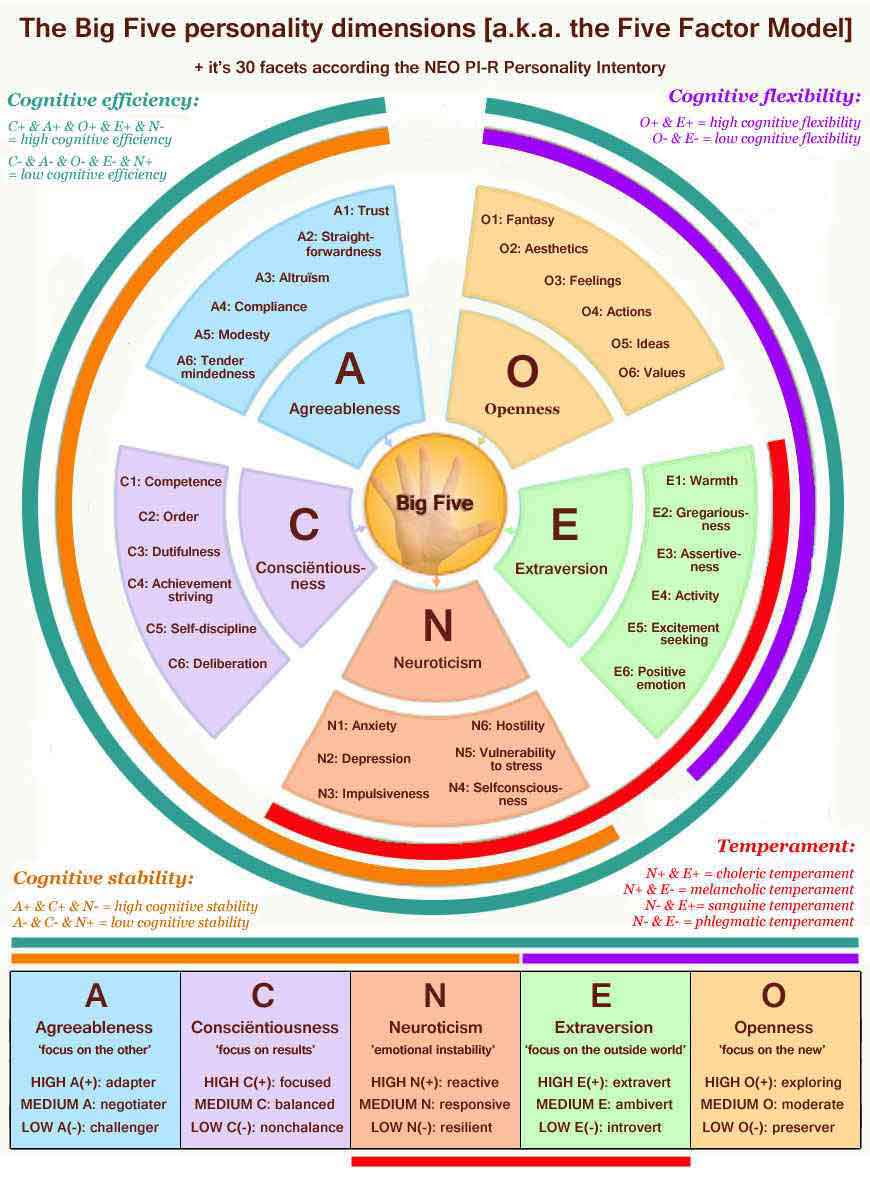
AGREEABLENESS - CONSCIENTIOUSNESS - NEUROTICISM - EXTRAVERSION - OPENNESS
A visual impression summarizing the outcome of
preceding hand research studies focused on high- and low scorers
in each of Big Five personality dimensions.
NOTICE: Not all details in the charts below resulting from a comparison between high- & low scorers
are consistent with the results reported in the present article (above) reported for the full populations.
